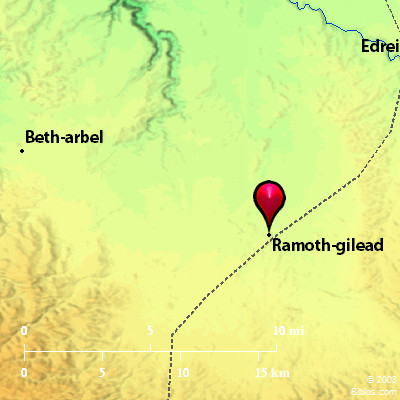Atlas  Ramoth-gilead and surrounding area Maps Created using Biblemapper 3.0 Additional data from OpenBible.info Occurrences 1 Kings 4:13 Ben Geber, in Ramoth Gilead (to him pertained the towns of Jair the son of Manasseh, which are in Gilead; even to him pertained1 Kings 22:3 The king of Israel said to his servants, "You know that Ramoth Gilead is ours, and we are still, and don't take it out of the hand of the king of Syria?" 1 Kings 22:4 He said to Jehoshaphat, "Will you go with me to battle to Ramoth Gilead?" Jehoshaphat said to the king of Israel, "I am as you are, my people as your people, my horses as your horses." 1 Kings 22:6 Then the king of Israel gathered the prophets together, about four hundred men, and said to them, "Shall I go against Ramoth Gilead to battle, or shall I forbear?" They said, "Go up; for the Lord will deliver it into the hand of the king." 1 Kings 22:12 All the prophets prophesied so, saying, "Go up to Ramoth Gilead, and prosper; for Yahweh will deliver it into the hand of the king." 1 Kings 22:15 When he had come to the king, the king said to him, "Micaiah, shall we go to Ramoth Gilead to battle, or shall we forbear?" He answered him, "Go up and prosper; and Yahweh will deliver it into the hand of the king." 1 Kings 22:20 Yahweh said,'Who shall entice Ahab, that he may go up and fall at Ramoth Gilead?' One said one thing; and another said another. 1 Kings 22:29 So the king of Israel and Jehoshaphat the king of Judah went up to Ramoth Gilead. 2 Kings 8:28 He went with Joram the son of Ahab to war against Hazael king of Syria at Ramoth Gilead: and the Syrians wounded Joram. 2 Kings 9:1 Elisha the prophet called one of the sons of the prophets, and said to him, "Gird up your waist, and take this vial of oil in your hand, and go to Ramoth Gilead. 2 Kings 9:4 So the young man, even the young man the prophet, went to Ramoth Gilead. 2 Kings 9:14 So Jehu the son of Jehoshaphat the son of Nimshi conspired against Joram. (Now Joram was keeping Ramoth Gilead, he and all Israel, because of Hazael king of Syria; 2 Chronicles 18:2 After certain years he went down to Ahab to Samaria. Ahab killed sheep and cattle for him in abundance, and for the people who were with him, and moved him to go up with him to Ramoth Gilead. 2 Chronicles 18:3 Ahab king of Israel said to Jehoshaphat king of Judah, Will you go with me to Ramoth Gilead? He answered him, I am as you are, and my people as your people; and we will be with you in the war. 2 Chronicles 18:5 Then the king of Israel gathered the prophets together, four hundred men, and said to them, Shall we go to Ramoth Gilead to battle, or shall I forbear? They said, Go up; for God will deliver it into the hand of the king. 2 Chronicles 18:11 All the prophets prophesied so, saying, Go up to Ramoth Gilead, and prosper; for Yahweh will deliver it into the hand of the king. 2 Chronicles 18:14 When he was come to the king, the king said to him, Micaiah, shall we go to Ramoth Gilead to battle, or shall I forbear? He said, Go up, and prosper; and they shall be delivered into your hand. 2 Chronicles 18:19 Yahweh said,'Who shall entice Ahab king of Israel, that he may go up and fall at Ramoth Gilead?' One spoke saying after this manner, and another saying after that manner. 2 Chronicles 18:28 So the king of Israel and Jehoshaphat the king of Judah went up to Ramoth Gilead. 2 Chronicles 22:5 He walked also after their counsel, and went with Jehoram the son of Ahab king of Israel to war against Hazael king of Syria at Ramoth Gilead: and the Syrians wounded Joram. Encyclopedia RAMOTH-GILEADra'-moth-gil'-e-ad (ramoth gil'adh; Codex Vaticanus Rhemmath Galadd; Codex Alexandrinus Rhammoth, and other forms): A great and strong city East of the Jordan in the territory of Gad, which played an important part in the wars of Israel. It is first mentioned in connection with the appointment of the Cities of Refuge (Deuteronomy 4:43 Joshua 20:8). It was assigned to the Merarite Levites (Joshua 21:38 1 Chronicles 6:80). In these four passages it is called "Ramoth in Gilead" (ramoth ba-gil'adh). This form is given wrongly by the King James Version in 1 Kings 22:3. In all other places the form "Ramoth-gilead" is used.e to the shape of a jaw-bone (Judges 15:9, 14, 19). It may have been in Wady es-Sarar, not far from Zorah and Timnath; but the available data do not permit of certain identification. RAMOTH-GILEAD, a Levitical city of Gad 25 ms. e. of Jordan, that is, if it is supposed to be at es Salt, 13 ms. s. of the Jabbok. It is 2740 ft. above the Mediterranean. Its site is not certainly known. Strong's Hebrew H7433: Ramoth Gilada city East of the Jordan |



